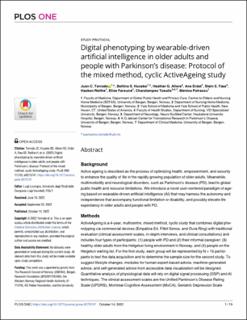| dc.contributor.author | Torrado Vidal, Juan Carlos | |
| dc.contributor.author | Husebø, Bettina Elisabeth Franziska | |
| dc.contributor.author | Allore, Heather G. | |
| dc.contributor.author | Erdal, Ane | |
| dc.contributor.author | Fæø, Stein Erik | |
| dc.contributor.author | Reithe, Haakon | |
| dc.contributor.author | Førsund, Elise | |
| dc.contributor.author | Tzoulis, Charalampos | |
| dc.contributor.author | Patrascu, Monica | |
| dc.date.accessioned | 2023-01-31T12:55:13Z | |
| dc.date.available | 2023-01-31T12:55:13Z | |
| dc.date.created | 2022-10-27T12:12:04Z | |
| dc.date.issued | 2022 | |
| dc.identifier.citation | PLOS ONE. 2022, 17:e0275747 (10), 1-19. | en_US |
| dc.identifier.issn | 1932-6203 | |
| dc.identifier.uri | https://hdl.handle.net/11250/3047434 | |
| dc.description | This is an open access article distributed under the terms of the Creative Commons Attribution License, which permits unrestricted use, distribution, and reproduction in any medium, provided the original author and source are credited. | en_US |
| dc.description.abstract | Background: Active ageing is described as the process of optimizing health, empowerment, and security to enhance the quality of life in the rapidly growing population of older adults. Meanwhile, multimorbidity and neurological disorders, such as Parkinson’s disease (PD), lead to global public health and resource limitations. We introduce a novel user-centered paradigm of ageing based on wearable-driven artificial intelligence (AI) that may harness the autonomy and independence that accompany functional limitation or disability, and possibly elevate life expectancy in older adults and people with PD.
Methods: ActiveAgeing is a 4-year, multicentre, mixed method, cyclic study that combines digital phenotyping via commercial devices (Empatica E4, Fitbit Sense, and Oura Ring) with traditional evaluation (clinical assessment scales, in-depth interviews, and clinical consultations) and includes four types of participants: (1) people with PD and (2) their informal caregiver; (3) healthy older adults from the Helgetun living environment in Norway, and (4) people on the Helgetun waiting list. For the first study, each group will be represented by N = 15 participants to test the data acquisition and to determine the sample size for the second study. To suggest lifestyle changes, modules for human expert-based advice, machine-generated advice, and self-generated advice from accessible data visualization will be designed. Quantitative analysis of physiological data will rely on digital signal processing (DSP) and AI techniques. The clinical assessment scales are the Unified Parkinson’s Disease Rating Scale (UPDRS), Montreal Cognitive Assessment (MoCA), Geriatric Depression Scale (GDS), Geriatric Anxiety Inventory (GAI), Apathy Evaluation Scale (AES), and the REM Sleep Behaviour Disorder Screening Questionnaire (RBDSQ). A qualitative inquiry will be carried out with individual and focus group interviews and analysed using a hermeneutic approach including narrative and thematic analysis techniques.
Discussion: We hypothesise that digital phenotyping is feasible to explore the ageing process from clinical and lifestyle perspectives including older adults and people with PD. Data is used for clinical decision-making by symptom tracking, predicting symptom evolution, and discovering new outcome measures for clinical trials. | en_US |
| dc.language.iso | eng | en_US |
| dc.publisher | Public Library of Science (PLOS) | en_US |
| dc.rights | Navngivelse 4.0 Internasjonal | * |
| dc.rights.uri | http://creativecommons.org/licenses/by/4.0/deed.no | * |
| dc.subject | Parkinson disease | en_US |
| dc.subject | elderly | en_US |
| dc.subject | aging | en_US |
| dc.subject | artificial Intelligence | en_US |
| dc.subject | sleep | en_US |
| dc.subject | caregivers | en_US |
| dc.subject | geriatric depression | en_US |
| dc.subject | heart rate | en_US |
| dc.title | Digital phenotyping by wearable-driven artificial intelligence in older adults and people with Parkinson's disease: Protocol of the mixed method, cyclic ActiveAgeing study | en_US |
| dc.type | Peer reviewed | en_US |
| dc.type | Journal article | en_US |
| dc.description.version | publishedVersion | en_US |
| dc.rights.holder | Copyright: © 2022 Torrado et al | en_US |
| dc.source.pagenumber | 1-19 | en_US |
| dc.source.volume | 17 | en_US |
| dc.source.journal | PLOS ONE | en_US |
| dc.source.issue | 10 | en_US |
| dc.identifier.doi | 10.1371/journal.pone.0275747 | |
| dc.identifier.cristin | 2065586 | |
| dc.relation.project | Norges forskningsråd: 288164 | en_US |
| cristin.ispublished | true | |
| cristin.fulltext | original | |
| cristin.qualitycode | 1 | |

